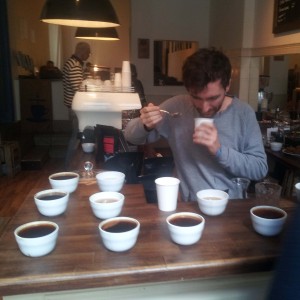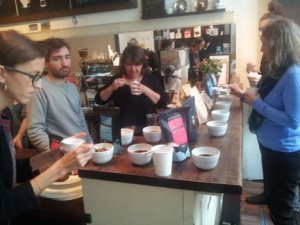I recently came across an article that likened certain sections of Berlin (“Berlyn”) to Brooklyn, NY. Apparently there is a good deal of cross-pollination occurring between these two urban hotspots. The other day I was invited by a friend to attend a coffee tasting in Penzlauer Berg, a neighborhood that has been compared to Brooklyn’s Park Slope. Or Williamsburg, I thought as I entered the shrine to coffee known as Cafe ck.
The coffee aroma in the cozy cafe was compelling. Soul music — Mavis Staples, James Brown — spun on a turntable tucked beneath the rear counter. A small shelf displayed trophies and plaques from various coffee-related competitions. The two bearded, twenty-something baristas behind the counter executed their work with earnest precision.
This was my first coffee tasting, or “cupping,” as I learned to call it. The eight participants included several other neophytes. We could tell the veteran cuppers: they had brought small notebooks in which to record their tasting notes.
My impression of being in an intimate Brooklyn cafe was reinforced when the barista who would be guiding our cupping asked in flawless English whether it would be okay for him to lead the tasting in English. I think he had overheard a few of us talking in English. We all nodded. It turned out that two other participants were, like my friend and me, from the US, two were from Spain, and the last two were German.
The tasting was initially done blind. Our coffee guide placed ten white bowls on the counter, and poured a different type of ground coffee beans into each one. We were invited to smell the grounds. I could distinguish differences in the aromas, but had trouble articulating them.
The barista then poured just-boiled water into each of the cups. A sort of slimy crust — the “crema” — formed on top. While we waited for the coffee to brew, the barista explained to us the various factors that give different coffees their distinct qualities.
As with wine grapes or cocoa beans, there are countless varieties of coffee beans, each with a unique flavor profile. The location in which the beans are grown — the terroir — influences the taste, as do the particulars of processing. Traditionally, green coffee beans were separated from the fruit’s fleshy pulp using a natural drying process. These days, most of the separating is done via a wet washing process.
“Are all of these coffees that we’ll be tasting varietals?” I asked, trying to sound knowledgeable.
“Mostly,” replied the barista. “One of the coffees is sourced from heirloom trees that grow wild in Ethiopia, so it’s difficult to know exactly what’s in it.”
According to our barista, green coffee beans should be roasted within eight to ten months of being harvested — and then consumed within three weeks of roasting. He compared the roasting process to making toast: “You can toast bread a little bit, and it still tastes mostly like bread. You can toast it a lot, to maximize the ‘toasted’ characteristics, and you can burn it if you toast it too much”. Roasting coffee beans causes acids to be formed, which can then be converted into sugars and other flavor compounds. Light roasts tend to be milder and more acidic, while darker roasts are more full-bodied.
The brewing method is another key determinant of the coffee’s taste. The roasting and grinding should suit the brewing method, and the proper techniques (water temperature and quality, brew time, etc.) should be used to brew the coffee.
My head was starting to spin, and we hadn’t yet imbibed any coffee. I suppose I might have guessed that coffee existed as such a high form of craft, but heretofore I hadn’t really given it much thought.
Our barista outfitted us each with a spoon and a paper cup. “You should slurp the coffee from the spoon to mix it with air. You are welcome to swallow the coffee that you are tasting, but most people find they are better off spitting it out.”
After precisely ten minutes of brewing time, our barista invited us to “break the crema.” I watched as others more experienced than I leaned over the cups, pushed back the top layer with their spoon, and inhaled deeply. We then slurped our way down the line.
“Pay attention to the different flavors you are tasting,” we were told. “Are they grassy? Nutty? Any fruit flavors? Dark chocolate? Note any coffees that you particularly like or dislike.” I didn’t really like any of them, although I enjoyed the challenge of distinguishing the flavor characteristics. Halfway down the line, I started swallowing my spoonfuls of coffee instead of spitting them out.
When we had finished, the barista asked us our impressions, and we discussed the various qualities we had experienced. The first three bowls contained different varietals from the same coffee plantation in Guatemala. The other coffees were from Columbia, Ecuador, El Salvador, Ethiopia, and Kenya. Most of the coffees had been wet-processed, but one had undergone a natural drying process. One of the coffees was an espresso roast — could we tell which one? I took more spoonfuls of coffee, trying to perceive the characteristics that the barista was attributing to the various brews. My body was buzzing.
With the “blind” phase of the cupping at an end, the barista brought out the bags of coffee one by one and placed them behind their respective cups. He briefly touched on the regions, varietals, and processes that shaped each of the coffees, but by that point my capacity for absorbing more coffee knowledge was saturated. I also realized, as my friend and I discussed our coffee-drinking habits, that since I typically drink my coffee with foamed milk, most of the flavor subtleties would probably continue to be lost on me. But I did appreciate being exposed to the world of coffee connoisseurship — it’s always inspiring to see experts practicing their craft.


